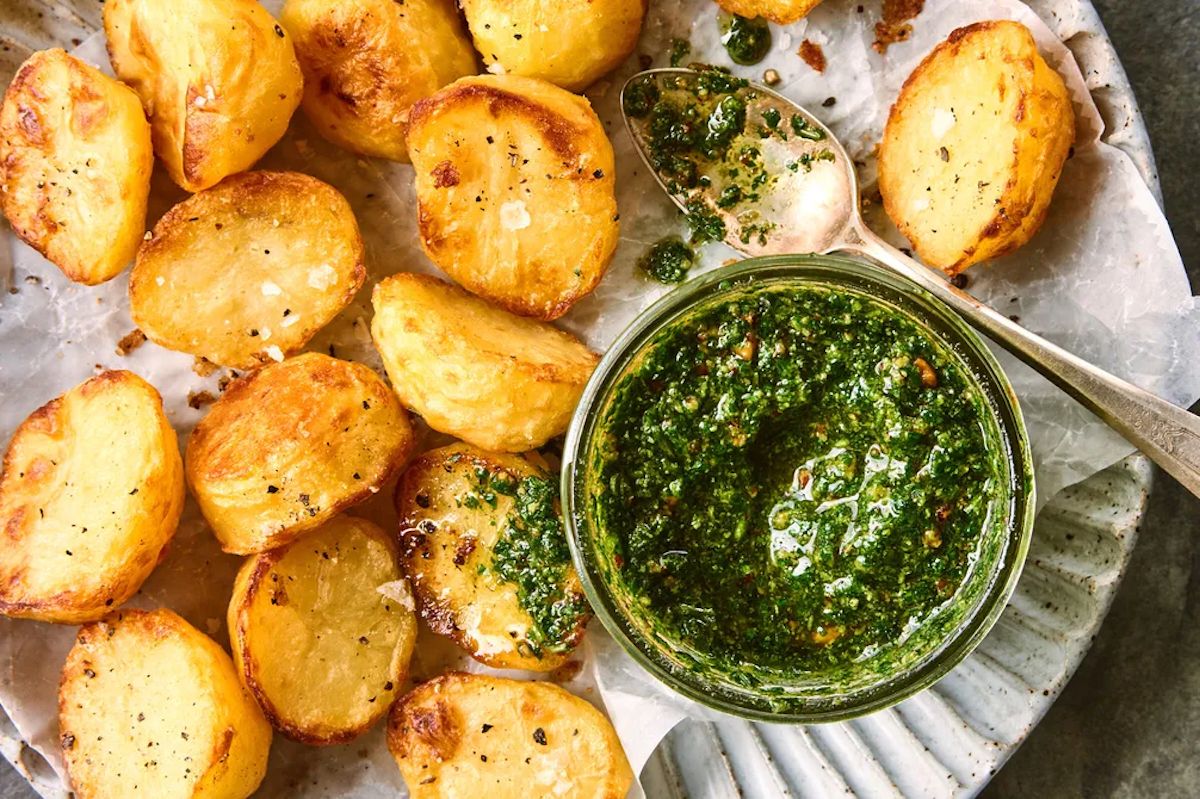Every month, Melina Hammer, Food52's very own Hudson Valley correspondent, is serving up all the bounty that upstate New York has to offer.
* * *
Now that it's early spring, I am overjoyed to discover tender garlic mustard, one of the first wild ingredients to sprout from the still-dormant upstate New York landscape.
Garlic mustard, Alliaria petiolata, also known as poor man's mustard or Jack-by-the-hedge, is a plant in the mustard (Brassicaceae) family, originally brought to the U.S. from Europe as a garden plant to help mitigate erosion. It is a biennial, sprouting vegetation in its first year, then after overwintering, it produces seeds in spring.
Garlic mustard is also an aggressively invasive species, suffocating the biodiversity of native plants. As The Nature Conservancy states, "Because the understory of a forest is so important for insects and other species at the bottom of the food chain, invaders like garlic mustard who emerge earlier than most native plants weaken the entire ecosystem."
You simply cannot overharvest this plant, and in fact, you're doing a service to native plants everywhere by picking it. I diligently do my part to hamper its spread by collecting it by the armful, and you can, too.
Where to find garlic mustard
Garlic mustard grows in many parts of the U.S. around forest edges, garden beds, disturbed woodlands, roadsides, and walking paths. It is one of the earliest spring plants, growing in squat bunches beginning in late March in the Hudson Valley, and reappearing in late fall. It is commonly found in parks, highway medians and shoulders, trails, urban areas, and gardens across the entire East Coast, Pacific Northwest, and Midwest. Unfortunately, garlic mustard has spread everywhere, save for ocean coastlines and the desert.
How to identify garlic mustard
Since it is one of the earliest green things to begin growing again in an otherwise brown landscape, it is fairly easy to identify — once you know what to look for. Garlic mustard's tender foliage is a rich, deep green. Leaves have a wrinkly surface and a rounded, serrated edge. When plants mature, leaves become more heart-shaped, with leaf tips more similar to knife points.
But don't just use your eyes: Crush a leaf in your hands — if it releases a strong garlicky, mustardy aroma, it is indeed garlic mustard. There are other plants sprouting at this time of year that marginally resemble garlic mustard (violets, which are a deeper green and do not have the serrated edge, and ground ivy, which is not wrinkly, and grows along the ground in a creeping fashion). None have the telltale aroma when their leaves are crushed either.
Garlic mustard, like other brassicas (broccoli, kale, cabbage, broccoli rabe) contains trace amounts of cyanide. Unless you're consuming a huge quantity of it, however, there's nothing to fear. If you want to be completely in the clear, know that the toxin is water soluble, so blanching, soaking, or boiling the greens prior to consuming will ensure safe enjoyment.
/d35ead1c-4f7e-412b-a611-4dcb48e841d0--GarlicMustard.jpg)
Photo by Melina Hammer.
How to pick and store it
When plants are young and present as clumps, harvest smaller leaves abundantly. As garlic mustard matures and sends up a juicy stem ending in a flower bud, cut or snap it off 4 to 7 inches down the stem — basically as long as you'd like, noting where the stem feels juicy, not fibrous. When garlic mustard is flowering, snap the uppermost part of the stem and flowers off between your fingers. If you're game to pull plants up by their roots, harvest the whole thing and take from it what you plan to use, then discard the rest in the garbage.
Rinse leaves and shake or pat them dry, then store in a container, sealed in the fridge. If you bring young stems home, store them in a tidy bunch in a plastic bag. If you harvested flowers, store them in a container as you would the leaves, but don't rinse them until just before using — flowers are delicate and will disintegrate if stored wet. Because these are picked at peak freshness, all but the flowers will last for up to 2 weeks, giving you ample time to devise many delicious ways to use this delicious ingredient.
What to do with it
When garlic mustard blooms, its sprays of white flowers give a wispy punch to salads, pizza, pasta, fish, and more. No need to cook them. Just sprinkle as a finishing touch.
One of my favorite times to harvest is when garlic mustard is still young. At this stage, it is excellent wilted in a cast-iron skillet and added to grains, beans, seared meats, pizzas, or toasts. Or, a quick and equally versatile preparation — and one of my favorites — is a pre-soaked raw, blitzed pesto sauce that also happens to be vegan.
Once the flower stem (petiole) shoots up from the bunch and flower buds have formed, the top 5 inches or so can be readily snapped off; they taste similar to broccoli rabe. Try chopping into bite-size pieces and sautéing.
Even garlic mustard roots are edible — they taste akin to horseradish. After scrubbing roots of their dirt, grate into salad dressings or marinades, or slice thinly to infuse vinegar or oils.
And their seeds? Yep, you guessed it: edible, too! Use seeds as you would mustard or black pepper, as a sprinkle to garnish pasta dishes, or, if you like to bake bread or crackers, as a sprinkle when finishing the dough, just prior to baking.
You can even use tiny garlic mustard sprouts as you would microgreens. They make an excellent topping to custardy eggs.
A couple recipes to get started
The green sauce is versatile: Toss it into pasta, slather it onto toast, or dip crispy roasted potatoes, as I have here. I sauté the tender stems similar to broccoli rabe, and pair them with grilled or seared fish or meats. This salmon dish is the epitome of spring.


Shares